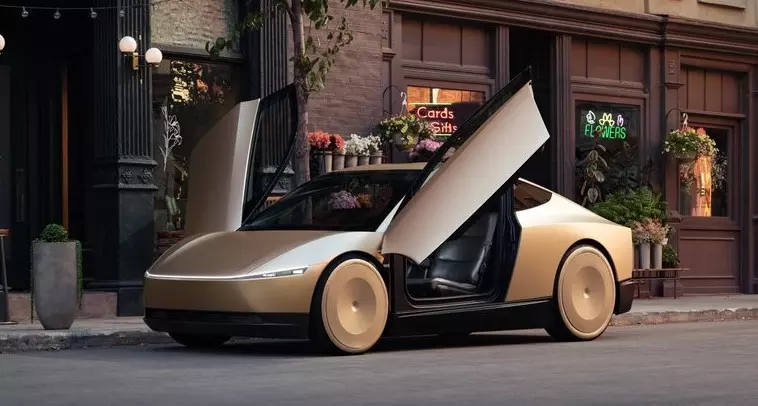
The prototype Cybercab, Tesla's revolutionary robotaxi that CEO Elon Musk presented at California on Thursday (October 10). Photo: X | @Tesla
Elon Musk unveils ‘Cybercab’, Tesla’s robotaxi – no steering wheel or pedals
It is part of Tesla’s vision of a future dominated by driverless technology, a truly autonomous vehicle that will not need human intervention for navigation and control

Elon Musk unveiled the “Cybercab”, Tesla’s long-awaited robotaxi, a fully-autonomous vehicle without steering wheels or pedals at the “We Robot” event at California on Thursday (October 10).
Musk arrived at the much-hyped event in one of the prototype Cybercabs.
The introduction of the Cybercab is part of Tesla’s vision of a future dominated by driverless technology. Musk’s objective has been to create a truly autonomous vehicle that will not need human intervention for navigation and control.
Cheaper and safer
“It will be cheaper than mass transit. They will be available for customers to buy at less than $30,000. They will cost 20 cents a mile to operate, compared to the $1 per mile for city buses,” said Musk at the event.
Also Read: Tesla to lay off 14,000 employees globally amid drop in EV sales: Report
He said that autonomous cars are expected to be 10-20 times safer than human-driven vehicles.
“This is a very big deal. It will save lives, a lot of lives, and prevent injuries,” he said.
Income generator
Musk’s plan is for Tesla to operate a fleet of Cybercabs that passengers can use through an app. Individual owners of the robotaxis will be able to generate an income on the app by listing their Cybercabs.
“The vast majority of the time, cars are just doing nothing. But if they’re autonomous, they could be used five times more, maybe 10 times more,” said Musk on stage at the event.
Time-saver
During the We Robot event, Musk presented the idea of autonomous cars as a time-saver.
“Think about the cumulative time that people spend in a car, and the time they will get back that they can now spend on their books or watching a movie or doing work or whatever,” he said.
Also Read: Mercedes-Benz India unfazed by Tesla's entry, says new EV policy has safeguards
Wireless charging
The Tesla CEO has been an evangelist on the importance of electric vehicles in reducing carbon emissions.
He has taken this commitment one step further with the Cybercab.
Also Read: Tesla’s humanoid: Performs yoga and greets with 'Namaste'
“The robotaxi will charge wirelessly using an inductive charger,” revealed Musk.
The company has been talking about wireless charging for its electric vehicles during events in the past and through its tweets.
The design
The Cybercab integrates futuristic design with functionality. The absence of a steering wheel and pedals provides more space for a flexible seating plan and other amenities.
Also Read: Tesla's electric car plant in Telangana? Talks are on
Musk did not give specific details about the car’s interior layout, but it is expected that the Tesla engineers will focus on maximising the passengers’ comfort and utility.
The car has two doors that open upwards like butterfly wings.
The timeline
The tech titan said that unsupervised, full self-driving capable cars should be available in Texas and California by next year on the Tesla Model 3 and Model Y for starters, and then Model S and Cybertruck also.
He said that the production of Cybercabs would start sometime in 2026, though he said it could be as late as 2027.
The challenges ahead
Autonomous vehicles experts have questioned Tesla’s approach to the technology, especially with regard to its Level 2 advanced driver-assist systems like Autopilot and Full Self-Driving (FSD).
There have been cases of accidents related to FSD. A 28-year-old motorcyclist was killed earlier this year by a Tesla driver allegedly using the self-driving technology. Tesla has been forced to recall its driver-assist systems due to increased government scrutiny.
Also Read: Elon Musk pays surprise visit to Beijing amid Chinese ‘curbs’ on Tesla cars
There have been several incidents of blocked vehicles, traffic jams, and some injuries as well connected with robotaxis. Federal safety regulators in the US have been investigating whether the technology behind these vehicles is safe or should be recalled.
Families of Tesla drivers who died in crashes involving Autopilot have sued the company for wrongful death.
The company will also need approval from regulators before going into production.
Musk’s vision for Tesla
The visionary businessman has been trying to move Tesla away from its core business of manufacturing and marketing electric vehicles towards one that produces robots and AI.
The Cybercab is a major step in that direction.

